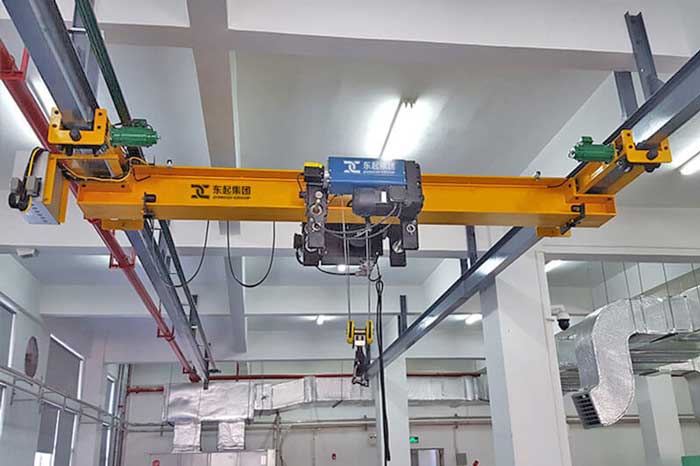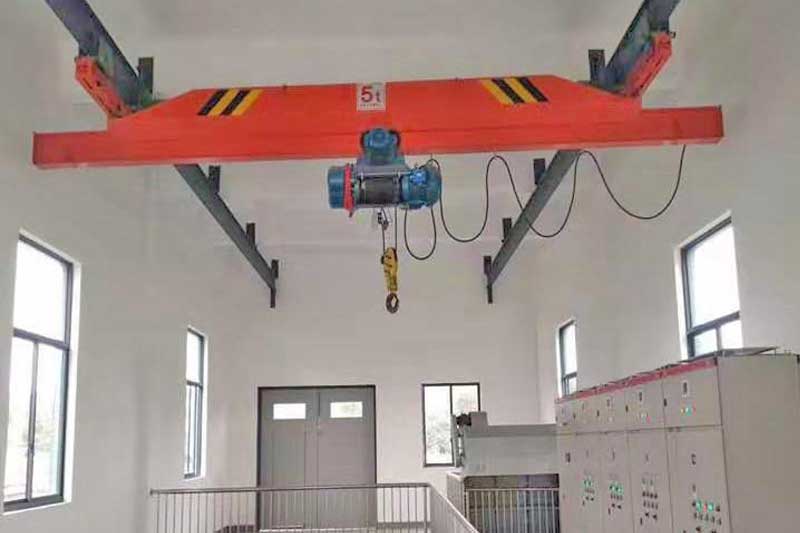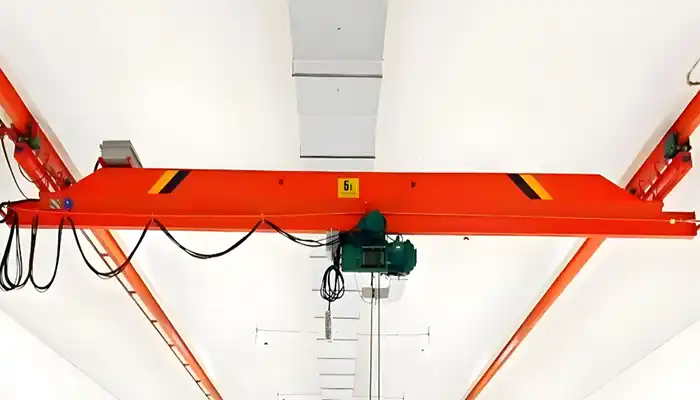How Much Does an Underslung Overhead Crane Cost?
A price guide for underslung overhead cranes in low-space workshops, covering factors like capacity, customization, and installation costs.
Introduction
What is an Underslung Overhead Crane? An underslung overhead crane is a type of crane that’s mounted underneath a ceiling track. Unlike regular overhead cranes, which are hung from above, the underslung design keeps the crane low and maximizes the space above. This makes it ideal for workshops with low ceilings or limited vertical space.
In smaller or more confined spaces, an underslung crane lets you lift heavy loads without taking up precious headroom. This is especially helpful in workshops where every bit of space counts.
So, you're probably asking, How much does an underslung crane actually cost? It's a good question, and the price can vary based on several factors. This price guide will help you get a clearer picture of what to expect when purchasing a crane for your workshop.
The goal is to give you the details you need to make an informed choice. Understanding what influences crane prices, from lifting capacity to custom features, will ensure you get the best value for your money.By the end of this guide, you'll have a solid grasp on crane pricing, so you can confidently choose the right option for your workshop needs.

What is an Underslung Overhead Crane?
An underslung overhead crane is designed to run on tracks mounted below the ceiling, rather than being supported from above. This makes it a great choice for workshops with low ceilings or limited vertical space. Unlike standard overhead cranes, it operates efficiently in compact areas without requiring major structural modifications.
Here’s a closer look at its key features and the advantages it offers in low-ceiling workshops.
Key Features of Underslung Cranes:
- Mounted Below the Ceiling – Runs on tracks fixed under the ceiling, saving headroom.
- Compact Design – Ideal for workshops with limited vertical space.
- Smooth Load Movement – Moves materials efficiently without obstructing overhead areas.
Advantages of Underslung Cranes in Low-Ceiling Workshops:
Even with space limitations, an underslung crane can provide efficient lifting and material handling. Here’s why it’s a smart choice for low-ceiling workshops:
Space Optimization
- Requires less overhead clearance compared to traditional cranes.
- Maximizes usable workshop space by keeping equipment lower.
- Works well in tight spaces without sacrificing lifting capacity.
Improved Load Lifting & Movement Efficiency
- Moves loads smoothly without interfering with ceiling-mounted equipment.
- Provides greater flexibility in navigating restricted spaces.
- Helps improve workflow by reaching different areas with ease.
Reduced Maintenance Needs
- Easier to access for inspections and servicing due to its lower positioning.
- Requires less frequent maintenance compared to overhead cranes.
- Saves time and costs on long-term upkeep.
For workshops with height restrictions, an underslung crane is an effective lifting solution. It allows for efficient material handling while making the most of available space.
Under running overhead crane for sale
Key Factors That Influence the Cost of Underslung Overhead Cranes
The cost of an underslung overhead crane isn’t fixed—it depends on several key factors. Everything from the crane’s size to the materials used can affect the final price. Understanding these factors will help you plan your budget and choose the best crane for your needs.
Lifting Capacity – How Much Weight the Crane Can Handle
The crane's lifting capacity is one of the biggest factors affecting its price. The more weight a crane can lift, the stronger its structure and components need to be, which increases the cost.
- Small Capacity (1–5 tons) – More affordable, suitable for light-duty applications.
- Medium Capacity (6–10 tons) – Mid-range pricing, used for moderate workloads.
- High Capacity (10+ tons) – More expensive due to heavier-duty materials and stronger hoists.
If your workshop only requires lifting lighter loads, choosing a lower-capacity crane can help you save money.
Span and Size – How Wide the Crane Needs to Be
The width of the crane (span) determines how much space it can cover. A larger span means a longer beam and stronger support structures, which increases the price.
- Short Span – Costs less but covers a smaller working area.
- Long Span – Requires more materials and engineering, making it more expensive.
It’s important to choose a span that fits your workshop without overspending on unnecessary size.
Customization Options – Extra Features That Add Cost
Standard underslung cranes are the most affordable, but if you need custom features, expect the price to go up. Common customizations include:
- Hoist Type – Manual hoists are cheaper, while electric or motorized hoists add cost.
- Control Systems – Basic pendant controls are standard, but wireless remote controls or automation features cost more.
- Safety Features – Overload protection, anti-sway systems, and emergency stop functions can increase the price but improve safety.
Adding these features can make your crane more efficient and safer, but they will impact your budget.
Materials and Build Quality – Durability Comes at a Price
The quality of materials used in the crane directly affects its durability and cost.
- Standard Steel – More affordable but may not be suitable for extreme conditions.
- High-Strength Alloy Steel – More expensive but offers better durability and load-bearing capacity.
- Corrosion-Resistant Coatings – Needed for harsh environments, adding to the overall cost.
Investing in high-quality materials ensures a longer lifespan and fewer maintenance costs over time.
Brand and Certification – Manufacturer Reputation Matters
A well-known manufacturer with a strong track record will typically charge more, but you get better reliability and after-sales service. Certifications also play a role in pricing.
- CE & ISO Certifications – Ensure quality and safety compliance but may increase the price.
- Reputable Brands – Usually more expensive than lesser-known manufacturers, but they offer better warranties and service.
Choosing a certified and reputable supplier can prevent issues with safety and long-term performance.
Installation and Maintenance – The Costs Beyond the Crane Itself
Buying a crane is just the first step—installation and ongoing maintenance also affect the total cost.
- Professional Installation – Required to ensure safety and proper setup, adding to initial costs.
- Long-Term Maintenance – Regular servicing, repairs, and spare parts can add to the total investment.
Skipping proper installation or maintenance can lead to costly repairs later, so it’s important to budget for these as well.
The price of an underslung overhead crane depends on multiple factors, from lifting capacity to customization and maintenance costs. By understanding these key points, you can make a well-informed decision that balances cost and performance for your workshop.
Price Ranges for Different Underslung Overhead Cranes
The cost of an underslung overhead crane depends on several factors, including lifting capacity, span, custom features, and installation requirements. Below is a general price guide based on different capacities to help workshop owners estimate their investment.
Low-Capacity Underslung Overhead Cranes (1–5 Tons)
These cranes are designed for light-duty lifting in small workshops, warehouses, and production facilities. They are the most affordable option and work well in low-ceiling environments.
Estimated price range: $3,000 – $10,000
Factors affecting the cost:
- Basic manual hoists or simple electric hoists keep costs lower.
- Shorter crane spans require fewer materials, reducing expenses.
- Standard configurations without custom modifications help minimize cost.
For businesses handling lightweight materials, a low-capacity underslung overhead crane is a budget-friendly choice.
Medium-Capacity Underslung Overhead Cranes (6–15 Tons)
These underslung cranes are ideal for medium-duty lifting in manufacturing plants and logistics centers, offering a balance between cost and performance.
Estimated price range: $10,000 – $30,000
What to expect:
- Stronger steel structures and reinforced hoists increase durability.
- Longer crane spans and higher lifting heights add to the cost.
- Additional features like remote control operation and safety systems increase price but improve efficiency.
For workshops needing greater load capacity while still working with height limitations, a medium-capacity underslung overhead crane is a practical option.
High-Capacity Underslung Overhead Cranes (16 Tons and Above)
Designed for heavy-duty applications, these underslung overhead cranes are used in steel mills, heavy manufacturing, and industrial warehouses where lifting large loads is essential.
Estimated price range: $30,000 – $100,000+
Why the higher cost?
- High-strength alloy steel and reinforced crane beams for durability.
- Advanced hoisting mechanisms, such as double-speed electric hoists or automated lifting systems.
- Complex installation requirements, often requiring custom rail systems and professional setup.
For industries that require heavy-duty lifting within space-restricted environments, a high-capacity underslung overhead crane is a long-term investment.
Additional Costs to Consider for an Underslung Overhead Crane
Aside from the base price of the underslung crane, other expenses should be factored into the total budget.
- Electrical systems: Wiring, power supply adjustments, and control panel setup ($1,000 – $5,000).
- Accessories and customizations: Special lifting hooks, load limiters, and anti-sway technology can increase costs.
- Installation costs: Professional crane installation may range from $2,000 – $10,000, depending on complexity.
- Ongoing maintenance: Regular inspection services, spare parts, and lubrication can add up to several hundred or thousand dollars annually.
The total cost of an underslung overhead crane depends on lifting capacity, workshop space requirements, and custom features. While low-capacity underslung cranes are affordable for small workshops, high-capacity cranes require a larger investment for industrial operations. Understanding both initial and long-term costs will help in choosing the right underslung crane for your workshop’s needs.
Common Customization Options and Their Cost Impact
Customizing an underslung overhead crane can improve safety, efficiency, and usability, but each modification adds to the overall cost. Below are some of the most common customization options and their impact on pricing.
Specialized Control Systems
Upgrading the control system of an underslung overhead crane enhances ease of use and precision but comes at an additional cost.
- Wireless remote control systems allow operators to control the crane from a safe distance, improving safety and convenience. Depending on the brand and features, this can add $500 to $3,000 to the total price.
- Radio frequency (RF) controls are a more advanced alternative to basic remote controls, offering better signal stability and range. These can cost $1,000 to $5,000.
- Variable frequency drives (VFDs) enable smooth acceleration and deceleration, reducing mechanical stress and improving crane lifespan. Adding a VFD system can increase costs by $1,500 to $4,000.
- Pendant controls with extended cables are a cheaper alternative but may limit the operator's mobility. These typically cost $300 to $1,500, depending on the length and durability.
Explosion-Proof Features
For workshops in industries such as oil and gas, chemicals, or mining, explosion-proof modifications are required to prevent sparks and electrical hazards.
- Explosion-proof hoists and motors are built with sealed casings and special materials to prevent ignition in hazardous environments. These can increase costs by 20% to 50% compared to standard models, often adding $5,000 to $15,000.
- ATEX or IECEx-certified components are required for operations in highly volatile areas. Certified explosion-proof cranes can cost $10,000 or more beyond the base crane price.
- Intrinsically safe control systems use low-energy circuits to reduce the risk of ignition, which can add $2,000 to $7,000, depending on complexity.
Safety Features
Safety is a top priority in any workshop, and adding extra protective features increases both security and cost.
- Overload protection systems prevent the crane from lifting beyond its rated capacity, reducing strain on components. This feature typically adds $500 to $2,000.
- Anti-collision sensors detect nearby objects and stop the crane to prevent accidents. These systems range from $1,000 to $5,000, depending on sensitivity and coverage area.
- Emergency stop systems allow instant halting of operations in case of malfunction. Basic versions cost $300 to $1,000, while more advanced setups can go up to $3,000.
- Limit switches prevent the hoist or trolley from over-traveling, protecting both the crane and the load. These typically cost $200 to $1,500.
Hoist and Drive System Upgrades
The type of hoist and drive system selected for an underslung overhead crane significantly impacts performance and pricing.
- Wire rope hoists offer greater durability and lifting power compared to chain hoists but cost more. A basic chain hoist may cost $2,000 to $6,000, while a wire rope hoist ranges from $5,000 to $20,000 depending on capacity.
- Double-speed or variable-speed hoists provide smoother and more precise lifting control, adding $1,500 to $4,000 to the total cost.
- High-efficiency motors reduce energy consumption and increase longevity but can raise costs by $1,000 to $5,000.
- Heavy-duty gearboxes improve torque and performance, especially for high-capacity cranes, adding $3,000 to $10,000 to the total price.
Customizations for underslung overhead cranes can significantly improve functionality, but each upgrade comes with added costs. Workshop owners should carefully consider which features are necessary for their operations to strike the right balance between performance, safety, and budget.
How to Estimate the Total Cost for Your Workshop
Calculating the total cost of an underslung overhead crane involves considering multiple factors, including lifting capacity, span, and customization needs. Below is a step-by-step guide to help workshop owners estimate their investment.
Step-by-Step Cost Estimation
To get an accurate estimate for your workshop, follow these steps:
- Determine the required lifting capacity – The crane's price increases with its lifting capacity. A 1-ton crane will be significantly cheaper than a 10-ton or 20-ton model.
- Measure the span and workshop layout – The longer the span, the more materials are needed, increasing the cost. Low-ceiling workshops may also require custom adjustments.
- Decide on control systems – Basic pendant controls are cheaper, while wireless remote control or variable frequency drives will increase the price.
- Evaluate safety and operational features – Features like overload protection, anti-collision sensors, and emergency stop systems add to the cost but improve safety.
- Consider installation and long-term maintenance – Professional installation, electrical setup, and future servicing should be included in the total budget.
Example Cost Breakdown for a Low-Space Workshop
Here’s an estimated cost breakdown for a typical underslung overhead crane setup in a small workshop:
- 1-5 ton underslung overhead crane – $5,000 to $12,000
- Span of 8-12 meters – Included in the base price, but larger spans may add $2,000 to $5,000
- Basic electric hoist – $2,000 to $6,000
- Wireless remote control – $1,000 to $3,000
- Overload protection and safety features – $500 to $2,500
- Installation and electrical work – $3,000 to $8,000
- Annual maintenance and spare parts – $1,000 to $3,000 per year
The total cost of an underslung overhead crane varies based on lifting capacity, workshop dimensions, and additional features. By carefully evaluating each factor, workshop owners can create a realistic budget and choose the best crane configuration for their needs.
Why Choose a Quality Underslung Crane for Your Workshop
Investing in a high-quality underslung overhead crane is about more than just the initial price. A well-built crane improves safety, reduces maintenance costs, and ensures smooth operations for years. While a cheaper option might seem attractive, it often leads to higher expenses in repairs and downtime.
Long-Term Investment Benefits
Choosing a reliable underslung crane can save money over time.
- Durability and lifespan – A well-constructed crane made from high-quality materials can last 15 to 25 years, reducing the need for frequent replacements.
- Lower maintenance costs – Cheap cranes often require more repairs, while a quality crane with durable components minimizes servicing costs.
- Energy efficiency – Advanced motors and smart control systems can lower power consumption, reducing electricity bills.
- Higher resale value – A well-maintained crane from a reputable brand retains more value if resold or upgraded in the future.
Safety, Reliability, and Downtime Reduction
A high-quality underslung crane improves workshop efficiency by reducing risks and unplanned stoppages.
- Enhanced safety features – Reliable overload protection, anti-collision sensors, and emergency stop systems help prevent accidents.
- Fewer breakdowns – A sturdy crane operates smoothly, avoiding costly delays in production.
- Consistent performance – Precision lifting mechanisms reduce errors, ensuring better handling of materials and improved workflow.
Paying more for a high-quality underslung overhead crane is a smart long-term decision. It provides better safety, lower operational costs, and long-lasting performance, making it a cost-effective investment for any workshop.
Conclusion
Understanding the pricing of an underslung overhead crane involves looking at multiple factors, including lifting capacity, span, customization options, and installation costs. While prices can range from a few thousand to over $100,000, the right choice depends on your workshop’s specific needs and budget.
- Lifting capacity – Heavier loads require stronger structures, increasing costs.
- Crane span and size – Longer spans demand more materials and higher manufacturing costs.
- Customization options – Advanced control systems, safety features, and explosion-proof designs add to the total price.
- Installation and maintenance – Professional setup and long-term servicing must be considered in the budget.
When selecting an underslung overhead crane, balance cost with functionality to ensure the best long-term value.
- Avoid choosing solely based on price – A cheaper crane may lead to higher repair and downtime costs.
- Invest in quality and safety – A well-built crane with proper certifications ensures reliable and secure operations.
- Plan for future growth – Choose a crane that can adapt to your workshop’s expansion needs.
An underslung overhead crane is a long-term investment that improves efficiency, safety, and productivity. By carefully evaluating your needs and budget, you can make an informed decision that provides the best return on investment for your workshop.





